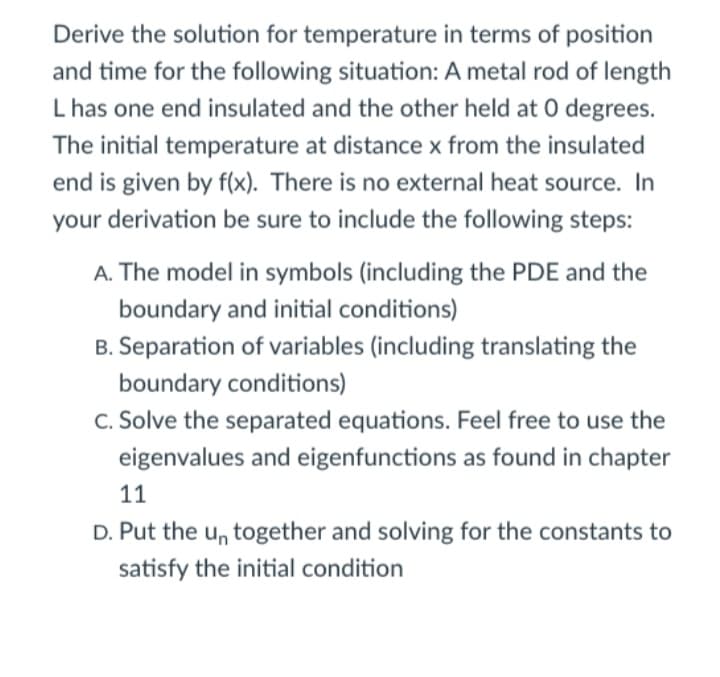Derive the solution for temperature in terms of position and time for the following situation: A metal rod of length L has one end insulated and the other held at 0 degrees. The initial temperature at distance x from the insulated end is given by f(x). There is no external heat source. In your derivation be sure to include the following steps: A. The model in symbols (including the PDE and the boundary and initial conditions) B. Separation of variables (including translating the boundary conditions) C. Solve the separated equations. Feel free to use the eigenvalues and eigenfunctions as found in chapter 11
Derive the solution for temperature in terms of position and time for the following situation: A metal rod of length L has one end insulated and the other held at 0 degrees. The initial temperature at distance x from the insulated end is given by f(x). There is no external heat source. In your derivation be sure to include the following steps: A. The model in symbols (including the PDE and the boundary and initial conditions) B. Separation of variables (including translating the boundary conditions) C. Solve the separated equations. Feel free to use the eigenvalues and eigenfunctions as found in chapter 11
Algebra & Trigonometry with Analytic Geometry
13th Edition
ISBN:9781133382119
Author:Swokowski
Publisher:Swokowski
Chapter5: Inverse, Exponential, And Logarithmic Functions
Section: Chapter Questions
Problem 18T
Related questions
Question
M7

Transcribed Image Text:Derive the solution for temperature in terms of position
and time for the following situation: A metal rod of length
L has one end insulated and the other held at 0 degrees.
The initial temperature at distance x from the insulated
end is given by f(x). There is no external heat source. In
your derivation be sure to include the following steps:
A. The model in symbols (including the PDE and the
boundary and initial conditions)
B. Separation of variables (including translating the
boundary conditions)
C. Solve the separated equations. Feel free to use the
eigenvalues and eigenfunctions as found in chapter
11
D. Put the un together and solving for the constants to
satisfy the initial condition
Expert Solution
This question has been solved!
Explore an expertly crafted, step-by-step solution for a thorough understanding of key concepts.
Step by step
Solved in 3 steps with 2 images

Recommended textbooks for you

Algebra & Trigonometry with Analytic Geometry
Algebra
ISBN:
9781133382119
Author:
Swokowski
Publisher:
Cengage

Algebra & Trigonometry with Analytic Geometry
Algebra
ISBN:
9781133382119
Author:
Swokowski
Publisher:
Cengage